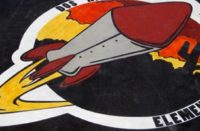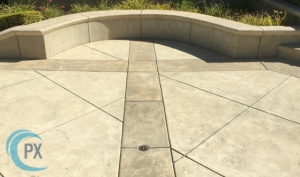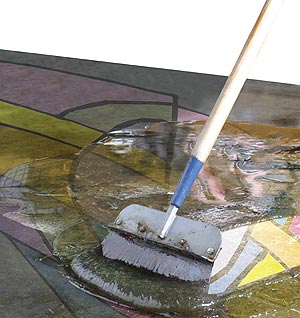 Stain removers are made specifically to counter the chemical composition of varying types of stains. Here’s a rundown on the most common types.
Stain removers are made specifically to counter the chemical composition of varying types of stains. Here’s a rundown on the most common types.
Removing stains from concrete is one of the necessary chores involved in prep work, but nobody’s idea of an adventure. Nevertheless, expect the unexpected.
“The first rule on cleaning paints, coatings, oil, stains, and so forth off concrete is “There are no rules,’” says Darryl Manuel, president of Vexcon Chemicals Inc.
Every situation is different, he says. The precise identities of coatings, stains and contaminants are usually unknown. Variables such as concrete porosity, depth of penetration, and strength of the surface layer all drastically change the parameters of the job.
Luckily for contractors, Vexcon and many other manufacturers produce stain removers that work as hard as they do. “Vexcon’s products are designed to be commercial-contractor viable, not reduced-efficiency products that are designed for mass marketing,” says Manuel.
Stain removal products for contractors are often specialized to work on a specific kind of stain, and sometimes, they are most effective only on certain chemicals that can cause that stain.
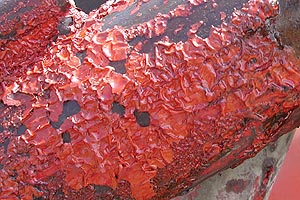
Removing paint
Take, for example, paint strippers. There are many different types of paint with varying chemical compositions, and a paint remover that works on one coating might not work on another, says Prosoco Inc. business communication specialist Gary Henry. “Be prepared to test more than one type of paint stripper,” he says.
Prosoco’s Enviro Klean Safety Peel is “a good place to start,” he says, especially if there might be more than one layer of paint to remove. Safety Peel comes in three versions chemically designed for different kinds of paint. Each includes a paste that is troweled onto the surface and covered with protective paper, then peeled off about a day later. Prosoco also sells gelled removers for tougher jobs.
Paint removers made by Surtec Inc. are solvent blends that conform to California and Northeast restrictions on VOC emissions. The company also produces a paint remover that is low in odor.
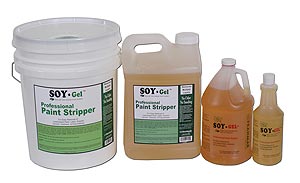
Franmar Chemical Inc. specializes in soybean-based environmentally friendly cleaners, and their Soy Gel Paint Remover is a good example. The gel will strip any coating from concrete — epoxies and urethanes as well as paint. A thick layer of the material will lift and dissolve one layer of paint after another. “The soy actually migrates through the coating,” says Jason Davenport, marketing director at Franmar Chemical Inc. “It literally migrates through the coating and just buckles it away from the surface.”
Soy Gel cleans up with water, unlike other strippers that need to be neutralized. And it is completely safe. “You could put this stuff on with your hands,” Davenport says.
The remover won’t evaporate like a petroleum-based stripper. And because it’s not hazardous material, it can be left on a floor out in the open. “If a dog came in off the street and licked the stuff, he might poop all week, but it isn’t going to hurt him,” Davenport says.
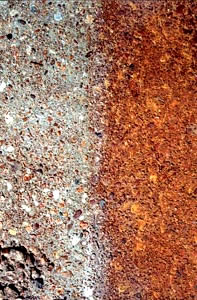
Removing rust
Rust stains happen when metal, either on or in concrete, is exposed to weather and water. “As the metal oxidizes or ‘rusts,’ the water carries tiny metal particles onto the concrete and into the concrete pores, creating stains,” explains Gary Henry of Prosoco. Aluminum creates white deposits, bronze and copper leave blue or green stains, and wrought iron creates orange stains, he says.
Prosoco produces several cleaners to combat rust: one for light, generalized stains, one for spot-cleaning heavy, deep-seated metallic stains, one for generalized rust stains, and a masonry cleaner for heavy stains on architectural block or decorative concrete.
The key to removing rust, says Davenport of Franmar, lies in one question: light or heavy?
Light rust can be scrubbed off with a light degreaser, such as a general-purpose household cleaner, and a scrub-brush, he says. “It will take surface rust right off.”
Rust that is embedded in the concrete, on the other hand, will need a specialty cleaner. And that specialty cleaner will most likely etch it out with acid.
Franmar Chemical’s rust removal product Emerge contains not soybeans, but a lightly acidic chemical. And it is recommended only for lighter rust. Heavy rust must be removed with heavy acid, Davenport says. “We stay away from very acidic petroleum products.”
Some companies make cleaners that deal with rust by changing its chemical composition, he adds.
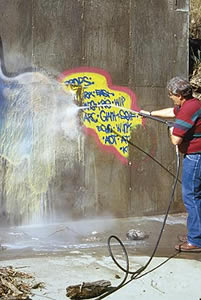 Surface Gel Tek LLC makes three gelled acid products that attack rust: a 20 percent acid solution for profiling, a 24 percent solution for cleaning and profiling, and a solution for stenciling.
Surface Gel Tek LLC makes three gelled acid products that attack rust: a 20 percent acid solution for profiling, a 24 percent solution for cleaning and profiling, and a solution for stenciling.
“Really, it does it by just eating the concrete that it is stuck to,” says Surface Gel Tek president Tamryn Doolan. “It’s actually etching it off the concrete, and it does it really fast too.”
The gelled acids work on adhesives to some degree, as well as paint overspray and spatter. Doolan says they are also effective on oil and hydraulic fluid stains.
In any of these cases, of course, the acidic product will roughen the profile of the concrete surface. Once the stain is removed, the slab will need to be hosed off with water to neutralize the gel.
Manuel of Vexcon notes that Certi-Vex Etch, one of his company’s rust removers, has an added benefit beyond its effectiveness. “Overapplication will not ‘burn’ or open up the concrete beyond where the surface becomes sandy, such as will occur with overapplication of muriatic acid,” he says. Vexcon’s rust-removing systems, Certi-Vex Etch and Rust & Stain Remover, are both acid-based and require neutralization with baking soda, ammonia or TSP.
Removing adhesives
The process of removing adhesives, whether they are left over from tape, carpet or tile, starts with the application of elbow grease. “First remove as much adhesive residue as possible by mechanical means,” says Henry of Prosoco.
Then, Prosoco recommends Sure Klean Fast Acting Stripper, made for debonding heavy-duty epoxies, acrylics, urethanes and mastics as well as for stripping paint.
Prosoco also makes liquid and gel removers for use on silicone adhesives. “The cleaner actually ‘digests’ silicone,” Henry says.
Franmar Chemical makes a soybean and citrus remover that attacks tape adhesives and a mastic remover for materials such as carpet glue. The mastic remover will linger on a surface for days without evaporating like water-based cleaners.
Soy cleaners, in general, have intense migration properties, Davenport says. “We have to specially coat our bottle, because it’ll actually migrate through the bottle,” he says. Soy is also a stable chemical to blend with other materials, he adds, so it won’t give off unexpected fumes or odors.
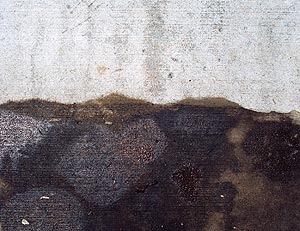
Removing oil & hydraulic fluids
Cleaners that attack oil and hydraulic fluids are called degreasers. Typically, they consist of detergents, solvents or citrus agents.
How to choose? “A lot of times it’s about economy,” says Mark Granados, chemist with Surtec Inc. “Water-based cleaners can be diluted with water. Citrus and solvent-based degreasers can only be diluted with solvents.”
For older oil stains, Prosoco recommends a combination of its Asphalt & Tar Remover with Stand Off Poultice Powder. This combination of liquid cleaner and blended clay powders forms an absorbent poultice paste.
Then there’s gelled acid from Surface Gel Tek. It’s mainly used on rust, but Doolan says it is also effective on oil and grease, drawing the contaminants to the surface for scraping. “Our product removes grease and oil as well as any products out there.”
Franmar’s soy-citrus adhesive remover will work on oil and tar up to a point, Davenport says, but as with rust, if the oil is embedded, a customer should be prepared for results that are somewhat mixed. “If the oil is impregnated into the concrete, again, you’re going to have some problems. Cleaning products tend to lighten it but you will still be able to see where it was.”
Use only as directed
Regardless of what stain is being lifted, Henry of Prosoco recommends testing. “Even when you’re absolutely sure of what you’re removing, and what to remove it with, test your product and procedure on a small, out-of-the-way part of the concrete. Test using the same products and procedures you plan to use for the overall cleaning. Test under the same conditions. A test in August might not be accurate for cleaning in October.” And, he warns, use the cleaner only as specified. “Results may be unpredictable if you use the cleaner for anything else,” he says. “Never dilute or mix any concrete cleaning agent with water or other substances unless specifically directed on the product label.”


